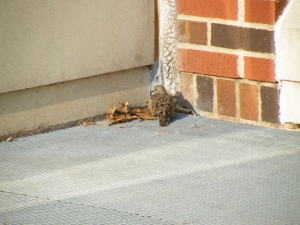
On August 20th, I completed a full year of regular surveys for window-killed birds at the Noble Research Center. Here are some vital statistics for August 20 2009–August 20 2010:
Effort.
I conducted (occasionally with help from assistants like Danielle Benson) 153 surveys over the full year of monitoring. This equates to an average of 2.39 days between surveys.
Coverage was irregular throughout the year. For example I did no monitoring in January 2010. For this reason, analysis of casualties by season must be viewed through the lens of dissimilarities in sampling effort among the seasons. I defined sampling effort as the number of surveys per days in a given season. I defined seasons as follows: Dec. 1–Mar. 20 (110 days) = “winter,” Mar. 21–May 20 (61 d) = “spring,” May 21–Aug. 19 (91 d) = “summer,” and Aug. 20–Nov. 30 (102 d) = “autumn.” The 11 winter surveys provided an effort of 0.10. This approximates 10 days on average between surveys. Effort indices were 0.87 for spring (53 surveys in 61 days), 0.44 for summer, and 0.48 for autumn. Thus effort was most consistent during spring with near daily surveys.
Data.
I recorded window strike mortality for 38 individuals of 22 different species over the year of monitoring. This rate of collision mortality places the NRC on par with other high-mortality buildings referenced in Klem 1990 and O’Connell 2001.
Of the 38 casualties, 5 were “local” (i.e., recently-fledged offspring of local breeders), 5 were “hatch year” birds (i.e., “immature”, or birds < 1 yr. old), and 28 were adults or of undetermined age.
Of the the 38 casualties, 8 were identifiable as male, 5 as female, and 25 were of undetermined sex.
I encountered more casualties during spring and fall migration periods than in winter or summer (though effort may have played a role in this result):

As in O’Connell 2001, Neotropical migrants in passage comprised the greatest percentage of individuals among all casualties. The birds dying at the NRC are not local residents that commonly occur in the OSU campus. These are transient individuals traveling long distances that just happen to meet their end here. (Note that the number of resident individuals among the casualties is inflated by the fact that 5 of the 7 casualties were recently fledged mourning doves and northern cardinals.)

Non-lethal collisions.
On at least four occasions, I encountered live birds that appeared to be trapped near a window but were not injured from a collision. These individuals are not included in the collision data, but they may have been had I not been there to flush them away from the windows and encourage them to move along:
9/22/09: Grasshopper Sparrow and suspected Swainson’s Thrush
10/19/09: Grasshopper Sparrow
11/2/09: Two Dark-eyed Juncos
6/21/10: Carolina Wren
Scavenging rate.
The scavenging rate proved to be unpredictable over the year. For example, some carcasses left in place remained visible for several weeks and were untouched during that time. Others were identifiable only from feathers left behind of a carcass that, based on the timing of my most recent survey, had been scavenged just a few hours after the bird’s unfortunate collision. Further confounding the interpretation of scavenging rates, some carcasses were scavenged but readily identifiable feathers of the carcass were left behind and still in evidence long after scavenging. For example, the Yellow-billed Cuckoo that I found on 6 June 2010 was scavenged on 15 June. As of 3 September 2010, that bird’s primaries are still readily apparent at the location where I first found it on June 10th, approximately 86 days after the bird’s death.

Scavenged Swainson’s Thrush.
I found evidence of 15 scavenged carcasses over the year. Thus, out of 38 total casualties, 39% were ultimately scavenged. (Of course, I collected the majority of the carcasses I found, most of which were fresh and in excellent condition and were photographed for entries in this blog. Presumably, a high percentage of these would ultimately have been scavenged.) Two carcasses were scavenged on day 0 and three were scavenged after just one day in situ. Four were in evidence for at least 30 days; the average number of days a carcass was apparent in place was 18.6 – nearly 8 times the length of time between consecutive surveys. Thus, the regular, frequent surveys provided ample opportunity to discover carcasses before they were removed or no longer visible. In addition, the most frequent condition of freshly scavenged carcasses of warbler-sized birds was a pile of remiges cleanly sheared off near the base of the feathers. Thus, even small birds were usually left in place after scavenging; this increased the probability that I would find the carcass even if it had been scavenged. Nonetheless, it is likely that at least some individuals were scavenged and removed from the site before I could document the casualty, so mortality rates calculated from my surveys must be viewed as underestimates of actual mortality.
Total data.
The following table lists all the species found as window collision casualties at the Noble Research Center, 8/20 2009–8/20 2010:
species number
Common Yellowthroat 5
Mourning Dove 5
Lincoln’s Sparrow 4
Black-and-White Warbler 3
Grasshopper Sparrow 3
Painted Bunting 2
Mourning Warbler 1
Gray Catbird 1
Wilson’s Warbler 1
Canada Warbler 1
Indigo Bunting 1
Orange-crowned Warbler 1
Song Sparrow 1
Nashville Warbler 1
Dark-eyed Junco 1
Sprague’s Pipit 1
Swainson’s Thrush 1
Orchard Oriole 1
Northern Cardinal 1
Yellow-billed Cuckoo 1
Ruby-throated Hummingbird 1
Carolina Wren 1
O’Connell2001


































































